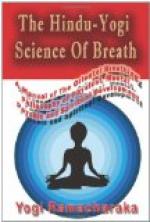We have explained that the ribs are fastened by cartilages, which admit of considerable expansion. In proper breathing, the ribs play an important part, and it is well to occasionally give them a little special exercise in order to preserve their elasticity. Standing or sitting in unnatural positions, to which many of the Western people are addicted, is apt to render the ribs more or less stiff and inelastic, and this exercise will do much to overcome same.
(1) Stand erect.
(2) Place the hands one on each side of the body, as high up under the armpits as convenient, the thumbs reaching toward the back, the palms on the side of the chest and the fingers to the front over the breast.
(3) Inhale a Complete Breath.
(4) Retain the air for a short time.
(5) Then gently squeeze
the sides, at the same time slowly
exhaling.
(6) Practice the cleansing breath.
Use moderation in this exercise and do not overdo its
(4) Chest expansion.
The chest is quite apt to be contracted from bending over one’s work, etc. This exercise is very good for the purpose of restoring natural conditions and gaining chest expansion.
(1) Stand erect.
(2) Inhale a Complete Breath.
(3) Retain the air.
(4) Extend both arms
forward and bring the two clenched
fists together on a
level with the shoulder.
(5) Then swing back
the fists vigorously until the arms
stand out straight sideways
from the shoulders.
(6) Then bring back
to Position 4, and swing to Position 5.
Repeat several times.
(7) Exhale vigorously through the opened mouth.
(8) Practice the Cleansing Breath.
Use moderation and do not overdo this exercise.
(5) Walking exercise.
(1) Walk with head up,
chin drawn slightly in, shoulders
back, and with measured
tread.
(2) Inhale a Complete
Breath, counting (mentally) 1, 2, 3,
4, 5, 6, 7, 8, one count
to each step, making the inhalation
extend over the eight
counts.
(3) Exhale slowly through
the nostrils, counting as
before—1,
2, 3, 4, 5, 6, 7, 8—one count to a step.
(4) Rest between breaths,
continuing walking and counting,
I, 2, 3, 4, 5, 8, 7,
8, one count to a step.
(5) Repeat until you
begin to feel tired. Then rest for a
while, and resume at
pleasure. Repeat several times a day.
Some Yogis vary this exercise by retaining the breath during a 1, 2, 3, 4, count, and then exhale in an eight-step count. Practice whichever plan seems most agreeable to you.
(6) Morning exercise.
(1) Stand erect in a
military attitude, head up, eyes front,
shoulders back, knees
stiff, hands at sides.




